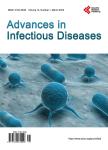Risk Factors Associated with Acinetobacter baumannii Infections in Patients in an Intensive Care Unit of a Public Hospital in Paraná
Risk Factors Associated with Acinetobacter baumannii Infections in Patients in an Intensive Care Unit of a Public Hospital in Paraná作者机构:Post-Graduante Program Health Sciences University of Wester Paraná (UNIOESTE) Francisco Beltrã o Brazil State of the Health of Paraná (SESA-PR) Francisco Beltrã o Brazil
出 版 物:《Advances in Infectious Diseases》 (传染病进展(英文))
年 卷 期:2022年第12卷第1期
页 面:90-105页
主 题:Acinetobacter baumannii Risk-Factors Infection Intensive Care
摘 要:To identify risk factors for A. baumannii infection in patients hospitalized in an Intensive Care Unit (ICU) of a tertiary public hospital in Paraná, Brazil, a retrospective paired case-control study (ratio 1:2) was conducted from January 2018 to December 2020. Patients in the case group were hospitalized in the ICU with A. baumanni (n = 68 cases) and were compared with patients in the control group, without infection by A. baumannii (n = 136). Both were matched by age (±10 years), sex, and ICU stay (±5 days). Conditional multiple logistic regression was used to determine statistically significant risk factors based on the results of bivariate analyses. Mortality was higher in infected (cases) than in non-infected patients (51.5% vs. 39.7%). The incidence and bacterial resistance increased annually. At bivariate analysis, cases had longer hospital stays (median 35 vs. 22 days, p A. baumannii and antimicrobial resistance. There is need for surveillance, and constant evaluation of control actions. Risk factors were colonization, previous hospitalization, and hospitalization time. This is essential for the decision-making of professionals and optimization of prevention, control, and therapeutic management actions.



